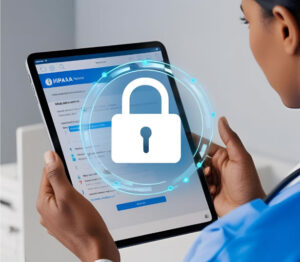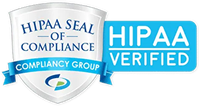Understanding rules is vital to avoiding HIPAA violations and facing serious consequences, as they include civil monetary penalties ranging from $141 to $2,134,831 per violation. In addition to financial penalties, you might need to take corrective actions to address deficiencies that lead to the violations. Lastly, if you’re a HIPAA-covered entity, you may need to adopt strategies to bring your policies and procedures to the HIPAA standards.
Overview of HIPAA and Its Importance
The Health Insurance Portability and Accountability Act (HIPAA), passed in 1996, is a federal law that protects private health information. It sets rules that healthcare providers, insurance companies, and related businesses must follow to keep patient data safe, including electronic medical records. HIPAA helps ensure that personal health details are not shared without permission and provides clear steps to securely handle, store, and share this information.
HIPAA helps to build trust between patients and healthcare providers. People want to know that their medical information is safe and kept private. HIPAA’s regulations force healthcare providers to take necessary precautions to avoid data breaches and unauthorized access to health records. Additionally, patients can see their records, decide who sees their information, and learn how their data is used.
What is a HIPAA Violation?
A HIPAA violation happens when a person or organization covered by the law fails to protect a patient’s private health information by accident or on purpose. This can include sharing health records without permission, failing to secure electronic data, or not training employees on handling sensitive information. Even something as simple as leaving a medical chart open on a computer screen where others can see it may be a violation.
Violations can lead to serious consequences. The U.S. Department of Health and Human Services (HHS) may investigate and issue fines based on the severity of the breach. A healthcare provider or vendor can face criminal charges if a patient’s health information is used for personal gain. Beyond penalties, a HIPAA violation can damage a healthcare provider’s reputation and break the trust patients place in them.
Common Types of Violations
HIPAA violations can take many forms. Three common violations include unauthorized access, lack of risk assessments, and poor staff training. Each poses a serious risk to patient data. Being aware of these can help maintain compliance and build trust.
Unauthorized Access and Disclosures: Unauthorized access occurs when someone views or shares patient information without permission. Preventing unauthorized access requires strict access controls and proper encryption to keep data safe.
Failure to Conduct Risk Assessments: Regular risk assessments are crucial for identifying potential vulnerabilities. Failure to do so can lead to unidentified risks and eventual data breaches. Conducting these assessments ensures that security measures are up-to-date. It helps prevent unauthorized access and maintain compliance.
Inadequate Staff Training: Proper training is essential for all healthcare employees. Staff must understand how to handle patient data securely. Lack of training leads to mistakes, such as improper disclosures or security lapses. Regular training ensures that everyone knows their responsibilities.
Key HIPAA Rules
HIPAA sets essential rules to protect patient information. There are three main rules: the Privacy Rule, the Security Rule, and the Breach Notification Rule. Each plays a vital role in protecting personal health information. By following them, healthcare providers ensure compliance and build trust with patients.
Privacy Rule
The Privacy Rule protects patient health information and ensures that data is only shared with authorized individuals. Patients have rights over their medical records, including accessing and requesting corrections. This rule requires providers to have clear policies on data use, which is essential for maintaining patient confidentiality.
Security Rule
The Security Rule focuses on protecting electronic health information. It requires protective measures such as encryption and access controls to ensure that only authorized personnel can access sensitive data. Regular risk assessments are also necessary under this rule.
Breach Notification Rule
The Breach Notification Rule requires providers to notify patients if their data is compromised. Notifications must also be sent to the government and, in some cases, the media. This rule ensures transparency and accountability. Quick action helps minimize the impact of a breach.
Consequences of Violations
HIPAA violations have serious consequences. Legal and financial penalties can be severe. Fines vary based on the violation’s nature and duration. They can range from thousands to millions of dollars. These penalties stress the importance of compliance and proper data handling.
Healthcare providers face legal action for HIPAA breaches. Fines depend on the level of negligence and harm caused. Violations can lead to lawsuits and significant financial loss, which impacts the organization and individual careers. Ensuring compliance helps avoid these costly outcomes.
Risk Areas and Vulnerabilities
Protecting patient data involves addressing several risk areas. Electronic health records (EHRs) are crucial but can be vulnerable. Regular software updates and access controls help keep EHRs secure from breaches.
Electronic Health Records (EHR)
EHRs contain detailed patient histories. Encryption and user authentication are key safeguards to protect an organization from potential data breaches. Additionally, all responsible staff members should be trained to recognize phishing attempts. Keeping EHR systems secure is essential for maintaining patient privacy and trust.
Unsecured email systems risk exposing sensitive information. Encryption tools can protect data during transmission. Educating staff about secure email practices is essential. This ensures that communication remains private and compliant.
Preventing HIPAA Violations
Preventing HIPAA violations is vital for protecting patient data. Implementing robust security measures is the first step. Use strong passwords and change them regularly. Encryption is essential for both emails and stored data. Regular audits help find and fix vulnerabilities. These practices create a secure environment for sensitive information.
Strong security measures are key to compliance. Ensure that all electronic systems are secure and regularly updated. Use firewalls and antivirus software to protect against cyber threats. Physical security, like locks and controlled access, is also essential. By combining these strategies, you can keep data safe from breaches.
Staff training is crucial for preventing mistakes. Teach employees about the importance of data protection. Regular workshops can keep them informed about new threats and best practices. Encourage a culture of vigilance and responsibility. Awareness helps minimize risks and ensures everyone knows their role in maintaining security.
Conducting Risk Assessments
Risk assessments help keep data safe. They show where weaknesses exist, allowing you to fix issues before they cause problems. Regular checks are essential to keep your security strong and compliant with HIPAA.
These assessments are vital for protecting patient information. They reveal threats and suggest improvements. Conducting them annually is best, but more frequent checks may be needed after changes. This keeps security measures up-to-date and effective.
Various tools help with risk assessments. The software can automate the process. Simple methods like lists and charts can also be helpful. Combining tools with expert insight ensures thorough protection. This approach ensures that all data stays secure and private.
Role of Business Associates
Business associates play a crucial role in handling patient data. They include any third-party partner that manages or processes this information. Ensuring they follow HIPAA rules is essential. Failure to comply can lead to violations. Therefore, choosing reliable partners is vital for maintaining data security.
Third-party partners must meet HIPAA standards. Regular checks and audits can ensure they follow the rules. Clear communication about compliance expectations is key. Healthcare providers can maintain high-security levels by working closely with these partners. This collaboration helps protect patient information effectively.
A Business Associate Agreement (BAA) is a legal contract. It outlines the responsibilities of both parties in protecting data. BAAs ensure that third-party partners comply with HIPAA. Establishing these agreements is crucial before any data exchange. They help clarify expectations and safeguard sensitive information.
Monitoring and Auditing
Monitoring and auditing help keep patient data safe and ensure security practices are followed. Regular checks can catch problems early, allowing healthcare providers to stop violations before they happen. It’s a proactive way to protect information.
Keep an eye on security measures constantly. Check access logs and update software regularly. Train staff to follow HIPAA rules. Doing these things ensures that everyone stays compliant. Regular monitoring prevents potential issues from growing.
Audit trails record who looks at data and when. They provide clear records of access and changes, which helps with transparency and accountability. Detailed logs help assess security, support compliance, and strengthen data protection.
Responding to Violations
Addressing HIPAA violations quickly is essential. First, identify and assess the breach. Determine what information was affected and how it happened. It’s crucial to contain the issue immediately. Quick action helps minimize potential harm, and promptly responding shows a data protection commitment.
Start by conducting a thorough investigation. Gather a team to review the details and understand the breach’s impact. Inform affected individuals and guide protective measures. Implement corrective steps to prevent future incidents. Document all findings and actions taken to maintain transparency.
HIPAA requires reporting breaches to the appropriate authorities. Notify the Department of Health and Human Services (HHS) promptly. If the breach affects many people, inform the media as well. Ensure all notifications are clear and detailed. Following these legal obligations helps maintain trust and compliance.
Corrective Action Plans
Creating a corrective action plan after a HIPAA violation is crucial. Start by identifying the root cause of the issue. Develop steps to fix the problem and prevent it from happening again. Each step should be clear and actionable. Involving the whole team ensures thorough implementation.
Begin by outlining specific actions needed to address the breach. Assign responsibilities to team members for each task. Ensure timely completion and regular updates on progress. Provide training to reinforce new procedures. This structured approach helps repair and strengthen data security.
Continuous monitoring is key to preventing future violations. Review and update security measures regularly. Keep staff informed with ongoing training sessions. Encourage a culture of accountability and vigilance. By maintaining these practices, healthcare providers can ensure compliance and protect sensitive data effectively.
Final Thoughts
Understanding HIPAA violations is vital for protecting patient information. We explored what violations are and how they occur. Key areas include unauthorized access, poor training, and lack of risk assessments. Knowing these helps avoid breaches and maintain trust.
We discussed the importance of monitoring, training, and auditing. Regular checks and staff education are crucial. Establishing strong security measures is a must. Tools like Business Associate Agreements and audit trails support compliance. These efforts collectively ensure data remains secure.
Staying compliant requires ongoing effort and vigilance. Keep up with changes in regulations and adapt as needed. Foster a culture of security awareness among staff. By prioritizing these actions, healthcare providers can protect both patients and themselves.





